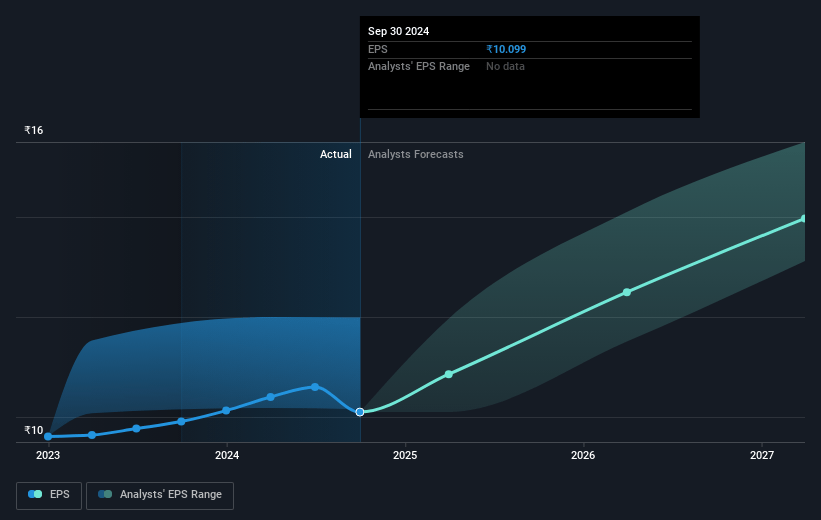Key Takeaways
- Expanding premium offerings and strategic channel initiatives aim to enhance revenue growth and net margins.
- Focus on international growth and strategic partnerships may drive operating efficiency and sustainable value creation.
- Unfavorable weather, competitive pressures, and currency risks threaten Dabur's revenue growth, net margins, and pricing power amidst inflation and stagnant demand.
Catalysts
About Dabur India- Operates as a fast-moving consumer goods company worldwide.
- Dabur India is focusing on expanding premium offerings and premiumization across various product categories, such as oral care and hair oils, which could lead to higher revenue and improved net margins.
- Strategic initiatives in emerging channels like e-commerce and modern trade are expected to drive revenue growth, as these channels account for more than 20% of the India business and continue to post robust double-digit growth.
- Dabur's international business is expected to continue growing strongly, with significant growth in regions like the Middle East, North Africa, Egypt, the U.K., the U.S., and Bangladesh, which could positively impact overall revenue and earnings.
- The company has partnered with McKinsey & Co to refine its strategy in light of market dynamics, which may lead to enhanced operating efficiency and sustainable value creation, potentially benefiting net margins and earnings.
- Dabur is planning product innovations and extensions in health supplements and beverages, while focusing on categories like health juices and oral care, which could revitalize sales growth and improve revenue streams.
Dabur India Future Earnings and Revenue Growth
Assumptions
How have these above catalysts been quantified?- Analysts are assuming Dabur India's revenue will grow by 9.4% annually over the next 3 years.
- Analysts assume that profit margins will increase from 14.3% today to 15.9% in 3 years time.
- Analysts expect earnings to reach ₹26.1 billion (and earnings per share of ₹14.18) by about April 2028, up from ₹18.0 billion today.
- In order for the above numbers to justify the analysts price target, the company would need to trade at a PE ratio of 54.8x on those 2028 earnings, up from 48.0x today. This future PE is greater than the current PE for the IN Personal Products industry at 49.4x.
- Analysts expect the number of shares outstanding to decline by 0.07% per year for the next 3 years.
- To value all of this in today's terms, we will use a discount rate of 13.64%, as per the Simply Wall St company report.
Dabur India Future Earnings Per Share Growth
Risks
What could happen that would invalidate this narrative?- Unfavorable weather conditions and a slowdown in consumption, particularly in urban areas, pose a risk to Dabur's revenue growth and could negatively impact net margins.
- The health supplements category, including key products like Chyawanprash and honey, is experiencing stagnation partly due to unfavorable weather, which could threaten future earnings.
- The competitive intensity in the juices and nectars category, driven by price wars and the entry of new products such as Campa Cola, may strain Dabur's pricing power and profit margins.
- Dabur's international business is vulnerable to currency devaluations in emerging markets, which could adversely impact consolidated revenue and net earnings.
- Inflationary pressures are expected to continue, potentially affecting Dabur's ability to maintain operating margins unless they successfully pass on costs through price increases.
Valuation
How have all the factors above been brought together to estimate a fair value?- The analysts have a consensus price target of ₹550.85 for Dabur India based on their expectations of its future earnings growth, profit margins and other risk factors. However, there is a degree of disagreement amongst analysts, with the most bullish reporting a price target of ₹660.0, and the most bearish reporting a price target of just ₹396.0.
- In order for you to agree with the analyst's consensus, you'd need to believe that by 2028, revenues will be ₹164.3 billion, earnings will come to ₹26.1 billion, and it would be trading on a PE ratio of 54.8x, assuming you use a discount rate of 13.6%.
- Given the current share price of ₹486.2, the analyst price target of ₹550.85 is 11.7% higher.
- We always encourage you to reach your own conclusions though. So sense check these analyst numbers against your own assumptions and expectations based on your understanding of the business and what you believe is probable.
How well do narratives help inform your perspective?
Disclaimer
Warren A.I. is a tool utilizing a Large Language Model (LLM) that ingests data on consensus price targets, forecasted revenue and earnings figures, as well as the transcripts of earnings calls to produce qualitative analysis. The narratives produced by Warren A.I. are general in nature and are based solely on analyst data and publicly-available material published by the respective companies. These scenarios are not indicative of the company's future performance and are exploratory in nature. Simply Wall St has no position in the company(s) mentioned. Simply Wall St may provide the securities issuer or related entities with website advertising services for a fee, on an arm's length basis. These relationships have no impact on the way we conduct our business, the content we host, or how our content is served to users. The price targets and estimates used are consensus data, and do not constitute a recommendation to buy or sell any stock, and they do not take account of your objectives, or your financial situation. Note that Warren A.I.'s analysis may not factor in the latest price-sensitive company announcements or qualitative material.




